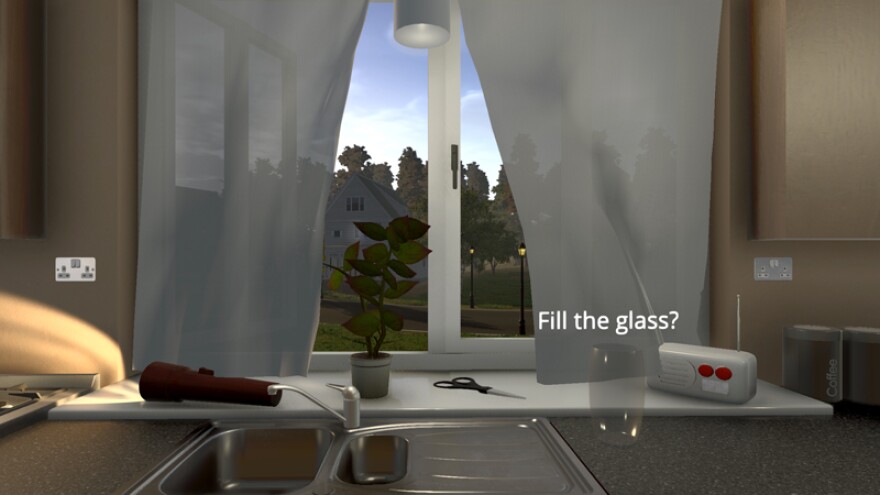This weekend an entire festival is dedicated to creative interpretations of October's historic flood by local artists. It's called Indie Grits, which typically celebrates southern culture in general, but organizers realized there hasn't yet been an artistic response to the flood. Six months after the disaster, fifteen local artists are coming together to tell stories of healing and resiliency through film, video games, music, and more.
One artist is responding to the flood through dance and film. Roni Henderson is shooting one of her last scenes today in the swamp of CongareeNational Park. She's pushing her equipment on a stroller down a dirt trail with the two dancers and composer walking ahead. They're looking for the right spot to set up shop, where there are cypress trees and shallow water.

The movie will be comprised of several dances capturing the range of emotion water can embody. Henderson says, "you think of water as soft, but honey, when she needs to, she get rough." Henderson says she felt like October's flood was a connected to a tragedy that occurred last June when nine black parishioners were shot during a bible study in Charleston. "And when the floods happen, I remember feeling, I wonder if these two things are connected. Just nature's response to an atrocity. Does nature respond to an atrocity, " she says.
Video: Roni Henderson directs dancers in the Congaree Swamp National Park in this clip from "Break (Through)."
It's questions like this that started Waterlines - the theme and primary focus of Indie Grits this year. Seth Gadsden is the curator, and says it was important for their community to have an avenue for an artistic response. He adds that artists are powerful communicators and can translate complex feelings into something tangible. Indie Grits organizers felt like there was an opportunity for art to play a role in the city's response to the disaster. They decided to commission artists to look at, "the way it heals, the way it remembers, looks, archives, show people things, and ways that they're not experiencing yet, whether it be an emotional way, or an analytical way."
"Some of... [the works] are going to be really devastating and heavy, others are going to be full of hope and joy, others are going to be humorous....That was the idea of inviting musicians, filmmakers, academics, freelancers." - Seth Gadsen, Waterlines curator
At the end of October, Gadsden gathered together fifteen local artists and started discussing their responses to the flood. Gadsden says the projects have a wide range, "some of them are going to be really devastating and heavy, others are going to be full of hope and joy, others are going to be humorous. I wanted it to have all these different things. That was the idea of inviting musicians, filmmakers, academics, freelancers. We tried to put together as diverse group as possible."
One filmmaker says his project is about coming to terms with the storm himself. On the night of the flood, Joshua Yates had friends staying in a cabin nearby. They were trapped inside, so he trekked through the flooded driveway and home in the middle of the night to get them out. The experience made him think about the many other flood victims stories, and began an oral history project. He heard one story about a father whose, "son thought it snowed because the watery clay in the backyard, and the way the morning sun hit it, it looked like snow." He adds that he's not rushing to finish it, "I would say I'm more invested in a product that I feel is cathartic and worthwhile as opposed to being focused on what the final outcome is."
A local musician wanted to capture the tension of the flood with his piece. Daniel Machado remembers hearing flood water slosh outside his house, and felt the need to recreate that tension somehow. As a musician, he says sound would be the most realistic way to do that, "In the end, it felt like, with music, I could turn it into an abstraction that was true to the little window of emotion and experience that I did have." It's a ten-minute piece where each minute is an audio snapshot of the days following the storm.
Video: Musician Daniel Machado explains his process.
Gadsden says art is a necessary response to the flood, aiding in the recovery process. He says, "hopefully, it will show city officials, funders, and different people... that art does play a role. It's not all about rebuilding infrastructure. It's making sure that we look at the stories... and make sure we remember them in a variety of ways." There are twelve other artists with original work that include performance, sculpture, photography, and more.
OneWaterlines artist, James Owens, adds the event is an appropriate way for the city to come back together, six months after the flood. He says, "I also think there's value in the fact that we experienced the flood as a city, so it wasn't a single persons experiencing the flood, we experienced it as a city. So now the festival gives us a chance to work through those experiences in art as a city."
Additional Links


